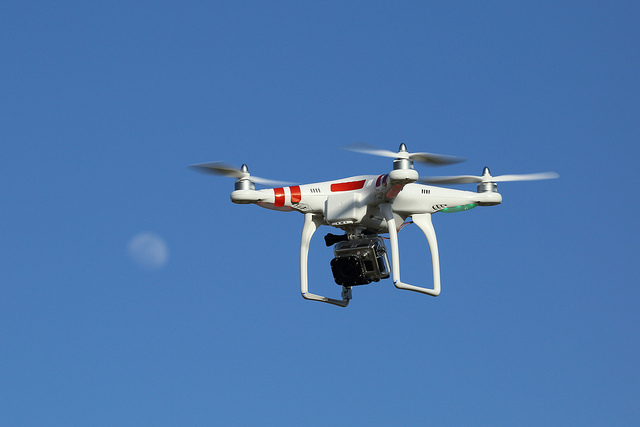Drone Surveillance Takes On Utility Scale Solar

Unmanned drones prove effective quality-control for utility-scale clean-tech projects.
When we think of large-scale quality control, or QC, we visualize engineers in hardhats with clipboards walking around a field of solar panels, for example. That image is rapidly becoming outdated, and one only need look to the skies to find out why.
Today’s drones, or unmanned aerial vehicles (UAVs), are more than twice as effective as human QC agents for a number of reasons. First, they can see much better, and from angles impossible for a human to achieve without wings. Second, they don’t get bored after the 115th mile of aboveground pipeline or solar panel proves to be functional. Third, they have no axe to grind if an entire section is defective. It’s not like they’re going to be forced to stick up for some corporate entity installer who also signs the personal paycheck, or a former inspector who spent most of the workday in a clean, dry, cool office.
In the technological future, even factories may become good surveillance venues. So might offices – though the idea of one’s boss looking like a mini-Dalish robot with wings might be too much for some to handle. But the one place where drone surveillance shines today is out in the field, checking on clean energy installations like wind and solar, for example.
Drones help clean-tech QC, siting surveys
According to Paul Curran, managing director of BQ Energy – a firm heavily vested in utility-scale solar and wind power – the drone provides unique project perspectives from a multitude of overhead angles, many too difficult for aircraft. Drones also help reveal siting or assembly flaws not evident at ground or near-ground level. For example, a section of hill which slopes in such a manner that one section of solar panels will inevitably be flooded, or another seldom receiving enough sunlight to activate.
UAVs, which are light, highly maneuverable, remote-controlled, and no longer as expensive as sin, have opened up a whole new world of possibilities not merely in the clean tech and QA verticals, but also in surveying and GIS (geographic information system) mapping. For example, what is the ideal camber, or cant, for a specific mountain road? From ground level, engineers may estimate four inches over a 2,000-foot span. A drone’s eye view may suggest something closer to two, and over a longer span, to insure that the rubber meets the road instead of leaping off it.
In solar applications – either those that are stationary or those that use tracking devices – drone surveillance may offer that seemingly small but enormously important edge in locating panels at the precise angle to capture every last photon. And, while this might be no more than a few kilowatts per panel, in a large array like Mojave Desert (BrightSource/Ivanpah) solar, these few extra kilowatts could power up to 10 additional energy-efficient homes – no small accomplishment in an era being driven by costs and climate toward increasingly clean sources of power.
Bottom line? These seemingly insignificant differences made possible by drone surveillance might, in fact, spell the difference between success and failure in a solar project.
As BQ Energy has discovered, combining ground observations with overhead UAV images taken at lower elevation and the slower speed of drones (vs. aircraft, for example) provides a dimension that has largely been unavailable up to now. Equally as important, at least in terms of costs, is the fact that UAVs can work alone, in harsh terrain, with no physical support. They don’t require sandwiches or water, shelter from the rain or snow, or rescue if the survey team of engineers meets a temperamental grizzly or rhinoceros.
Another company is also planning to use drones for solar energy, but in an entirely different way. New Wave Energy, a UK-based firm, foresees a time when airborne drones will actually support small solar arrays or wind turbines, using the drone’s ability to rise above cloud cover to insure greater efficiency and electricity delivery. Some are calling this pie-in-the-sky, but the company has already thought ahead to its own Kickstarter campaign.
How else could drones benefit the clean energy sector? For George Bye, founder of Bye Aerospace in Denver, Colorado, a maker of UAVs, the mantra is “higher and longer.” In other words, second- and third-generation drones may be able to achieve outstanding altitudes and operational times with only a few tweaks. Bye sees the benefits in border patrol and national security. Solar energy firms are more likely to count the advantages in dollars and cents. Either way, it’s a fascinating image – sunlight-powered drones monitoring a solar array in difficult climates like the Mojave, marking damaged, defective, or non-operational panels, trackers, or grids so that technicians only have to make a single pass to repair them.
And when the solar-powered drones also become robotic, able to repair the very solar panels they monitor …?
More: Drone’s Are Becoming Energy’s New Roustabouts (Nytimes)
Photo Credit: https://flic.kr/p/ei1iWe
